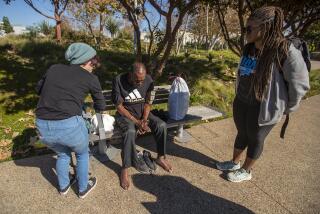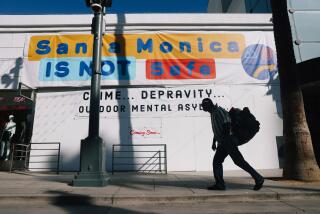Panel’s Stance on Alcohol Policy Shifts : Business: Planning Commission softens opposition to proposed controls after a show of force from bar owners, restaurateurs and industry representatives.
- Share via
SANTA MONICA — It was the revenge of the restaurants.
For the past month, those who want tougher controls on the availability of alcohol in Santa Monica have tried to link the city’s alcohol-serving restaurants and bars to almost every conceivable social ill, from fetal alcohol syndrome to increased gang activity.
But last week--at a five-and-a-half hour Planning Commission hearing that lasted until 1:30 a.m.--servers had their say on a proposed citywide alcohol policy.
Approximately 50 local bar owners, restaurateurs and industry representatives spoke out.Many of them complained that the policy unfairly targets their establishments for excess regulation and would make it harder for them to do business in an already unforgiving economic climate.
“The fact is a lot of people won’t want to be in business in this city,” restaurant broker and developer Irv Segal told the board.
Following the show of force, whatever commission support there had been for the staff-produced policy seemed to wither fast.
“I didn’t like what was put out there in the first place (as a policy),” commissioner Jennifer Polhemus said.
Polhemus has been among the leaders on the panel calling for stiffer regulation of outlets serving alcohol, but by late last week she was striking a conciliatory tone toward restaurants and bars. “What I’m planning on proposing would not hurt their businesses,” she said.
She called for a list of easy-to-understand alcohol regulations that will serve city planning interests without putting bar and restaurant owners at a competitive disadvantage.
Her main goal, she said, is that the city be able to review businesses that seek to drastically alter their operation, say from a restaurant to a nightclub.
The current alcohol policy proposal was developed in response to fears that Santa Monica is becoming what one resident called “the watering hole on the water.” The city now has 323 licensed alcohol outlets, among the highest per capita in Los Angeles County.
For the most part, the new regulations would not affect existing outlets, but would require 1,000 feet between future alcohol outlets and such sensitive locations as schools, churches and hospitals.
Other elements of the policy seek to regulate the behavior of clientele.
For example, serving alcohol in the bar areas of restaurants after midnight would be banned unless the customer was ordering food.
The policy has drawn fire from those who question how the city intends to define such concepts as “large bar,” “over-concentration of outlets” and other terms that dot the policy.
Especially controversial is the part of the plan that would require small restaurants that sell alcohol to obtain a conditional-use permit.
Although current operators would not be required to get the permit, many fear potential buyers might be scared off by the prospect of facing any number of municipally imposed conditions.
“If you do hook up with someone (a buyer), you want to make it as simple as possible,” said Dan Ringwood, owner of Teasers on the Promenade.
Several people said it was misleading to blame the surge of outlets downtown for rising crime there.
“Where you have great concentrations of people, you have great concentrations of crime,” said Gerald Breitbart of the California Restaurant Assn.
Police Crime Prevention Supervisor Donald Umber said higher crime statistics may merely reflect more people using an area--and don’t necessarily mean the zone is unsafe.
Brandishing a computer printout of crime statistics, Stephanie Barbanell, an anti-alcohol activist, repeated her plea that no more licenses be granted downtown until crime rates there fall into line with the rest of the city.
One downtown district had 57.7% more crime than the citywide average, according to police figures.
More to Read
Sign up for Essential California
The most important California stories and recommendations in your inbox every morning.
You may occasionally receive promotional content from the Los Angeles Times.










